






Over the past year, my husband, Mark, and I saved and planned a big vacation for our 15th wedding anniversary. It involved a lot of work, including driving 14 hours oneway to drop our children off in Louisiana with family, taking multiple flights to various connecting airports, securing our Covid results, immigration, customs, etc. But the joy of spending a whole week in the Caribbean with time to focus on just the two of us as a married couple made all of the hurdles worth it. This, I thought, is what joy is all about.
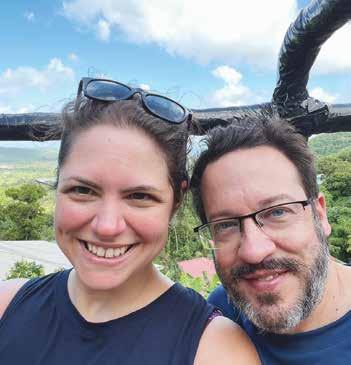
When we arrived in St. Lucia, our enthusiastic chauffeur took us on an hour-long drive through the curving mountains (with no sign of guardrails or even traffic laws) and snakeinfested rainforests—while we battled the onset of motion sickness. It was a rough go, but we did it. And when we finally got to our resort, I thought, “Ah, this is what joy is all about.”
A couple of days into our trip, Mark and I took an island tour with seven other visitors, piling into the back of an open-top jeep with our guide, a local woman, and our efficient driver. Throughout the day, she kept us laughing with jokes and stories as we navigated through a rainforest and visited a local beach. Then, they took us to a fishing village, the true face of the local people. For there, nestled in between the beautiful resorts, beaches and rainforests, was a modest community. Perhaps modest is too gentle a word. Houses were nailed together with rotting boards, and chickens and hungry dogs roamed the dirt-crusted streets.
But in the midst of poverty, a Catholic choir, donned in bright colors, sang Gospel music as the children of fishing families jumped into the Caribbean. It was a stark contrast: the dilapidated buildings and the happy people. It struck a chord in my heart. This, I thought, is what joy is all about.
On the drive back to our resort, our guide asked if she could share a spiritual story. She explained that many families in St. Lucia collect their drinking water in rain barrels as maintaining enough clean water is essential to survival. One day, her grandmother accidentally drained all of their stored drinking water during a dry season, and they began to despair. Together, their family gathered and prayed to God for a miracle. Out of nowhere, a storm rolled in and dumped so much rain that their water barrel overflowed. As soon as their barrel was full, the rain disappeared completely. Our guide told us it was one the most amazing and miraculous spiritual experiences of her life. As goosebumps raced up and down my arms, I again thought, “This is what joy is all about.”
And that’s when it finally hit me. All of these special, Godgiven things are what joy is all about: celebrating a marriage milestone, taking a long-planned-for vacation, spending time together as a married couple. But so, too, are the many things we take for granted, like the freedom to gather and pray openly and, yes, even something so basic as clean water.
As you read our “joy issue” this month, I encourage you to meditate on the things you take for granted in life that bring you—and others—joy!
cteditorial@catholicaoc.org

191st Year No. 11 • November 2022 513-263-6635 • thecatholictelegraph.com 100 East Eighth St., Cincinnati, OH 45202 ctadvertising@catholicaoc.org
The Catholic Telegraph (xUSPS 094-520) ISSN. 10736689 is published monthly by the Archdiocese of Cincinnati 100 E 8th St., Cincinnati, OH 45202. Periodicals postage paid at Cincinnati and at additional mailing office.
POSTMASTER: Send address changes to: The Catholic Telegraph, 100 E. 8th St., Cincinnati, OH 45202
PRIMO AVERION
DAVID ENDRES
BY: MARGARET SWENSEN
Father George Jacquemin tends the bees on his family farm.

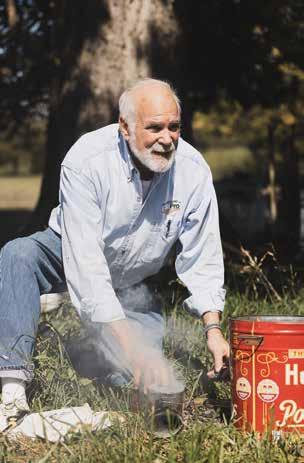
JOHN STEGEMAN
Found in the students and chaplain at Royalmont Academy
KARY ELLEN BERGER Marianist Father Bob Jones embraces vocation with goodness and hope
JILLIAN FOSTER
A reflection from a Haitian missionary
NET missionaries travel across the country to evangelize youth with grace, purpose &
EILEEN CONNELLY, OSU
George Jacquemin finds
in the little
FATHER ETHAN MOORE
KARY ELLEN BERGER
joy in sharing God’s gifts
FATHER DAVID ENDRES
Baptism of
DR. KENNETH CRAYCRAFT Joy is in the “how” not the “what”
DOMINICK ALBANO
The four fonts of joy
NICHOLAS HARDESTY
The challenge and blessing of hospitality
34 CATHOLIC AT HOME KATIE SCIBA
Don’t be a fan of the saints
DID YOU KNOW? GAIL FINKE + EMMA CASSANI St. Ann
KIDS’ CORNER
Stanislaus
DR. ANDREW SODERGREN
The tragedy of sin - part 1
42 THE FINAL WORD NANCY-CAROLYN SMITH
I’ve got the joy down in my heart
pray for children who are suffering, especially those who are homeless,
and victims of war; may they be guaranteed access to education
the opportunity to experience family affection.

More than simply an emotion we experience from time to time, joy is a virtue each of us is called to receive from God and cultivate in our lives for the good of others. Christian joy is rooted in an awareness of God’s unconditional love. When we experience God’s love and live out our lives as a response to that love, then we are truly joyful people.
On the evening before His Passion, our Lord reminded His closest disciples, “I have told you all this so that my joy may be in you and your joy may be complete” (Jn. 15:11). Jesus told His disciples about the suffering He would endure and their mission to carry on the work He had begun. After washing their feet, Jesus gave them the new commandment to love one another as He loved them. He encouraged them by promising that He would send the Holy Spirit to support, teach and guide them. He warned that they would face difficulties, challenges and rejection by the world. But Jesus told His disciples these things so they might share in His joy, a joy unlike anything the world could provide.
Even on the eve of His suffering and death, Jesus possessed deep joy because He remained intent on freely fulfilling the will of His heavenly Father. Jesus trusted in the Father’s plan for His life, and He knew that fulfilling that would bring Him the most satisfaction.
Everything Jesus teaches us is directed at leading us closer to God and helping us to know God’s plan for our lives. Jesus’ teachings show us who we are and what God calls us to be. They mark out the path we are to follow to reach our fulfillment as human beings created in God’s image. Even when we struggle along the way, God never tires of picking us up and putting us back on the road of discipleship.
Our joy is rooted in this hope of God’s never-failing love for us. Joy is a virtue that rests deep in our souls, but which we are meant to share with others. Unfortunately, we live in a world that, despite all the means of communication available to us, is becoming more and more hostile to genuine human encounter and mutual support.
Pope Francis began his Apostolic Exhortation Evangelii Gaudium, saying, “Whenever our interior life becomes caught up in its own interests and concerns, there is no longer room for others, no place for the poor. God’s voice is no longer heard, the quiet joy of his love is no longer felt, and the desire to do good fades. This is a very real danger for believers, too. Many fall prey to it, and end up resentful, angry and listless. That is no way to live a dignified and fulfilled life; it is not God’s will for us, nor is it the life in the Spirit which has its source in the heart of the risen Christ” (EG 2).
The joy which fills our heart as we receive God’s love for us is given to us precisely to be given away. Christians who share their joy make great contributions to the world by giving firm testimony to the love of God for all people.
November’s Catholic liturgies foster our contemplation of eternity. We celebrate All Saints’ Day and commemorate all the faithful departed on All Souls’ Day. The readings of the Sunday Masses offer reflections on the end times and God’s promise of salvation for those who place their trust in Him. Glancing toward eternity, we are filled with joy at the prospect of all God has in store for us. This is a fitting month, then, to renew our awareness of God’s great love. The Lord sends us out to be His joyful witnesses, confident in His grace and mercy, giving to a suffering world the hope of divine love.
Más que una sencilla emoción que experimentamos de vez en cuando, la alegría es una virtud que cada uno de nosotros está llamado a recibir de Dios y a cultivar en nuestra vida para el bien de los demás. La alegría cristiana se basa en la conciencia del amor incondicional de Dios. Cuando experimentamos el amor de Dios y vivimos nuestras vidas como respuesta a ese amor, entonces somos personas verdaderamente alegres.
La noche antes a su Pasión, el Señor les recordó a sus discípulos más cercanos: “Les he dicho esto para que mi gozo sea el de ustedes, y ese gozo sea perfecto” (Jn. 15:11). Jesús habló a sus discípulos del sufrimiento que iba a padecer y de su misión de continuar la obra que Él había comenzado. Después de lavarles los pies, Jesús les dio el nuevo mandamiento de amarse los unos a los otros como Él los amaba. Los animó al prometerles que enviaría al Espíritu Santo para apoyarlos, enseñarlos y guiarlos. Les advirtió que enfrentarían dificultades, retos y el rechazo del mundo. Pero Jesús les dijo a sus discípulos estas cosas para que pudieran compartir su alegría, una alegría no parecida a nada de lo que el mundo pudiese ofrecer.
Incluso en la víspera de su sufrimiento y muerte, Jesús poseía una profunda alegría porque seguía empeñado en cumplir libremente la voluntad de su Padre celestial. Jesús confiaba en el plan del Padre para su vida, y sabía que cumplirlo le daría la mayor satisfacción.
Todo lo que Jesús nos enseña está dirigido a que nos acerquemos a Dios y a ayudarnos a conocer el plan de Dios para nuestras vidas. Las enseñanzas de Jesús nos muestran quiénes somos y lo que Dios nos llama a ser. Marcan el camino que debemos seguir para alcanzar nuestra plenitud como seres humanos creados a imagen de Dios. Incluso cuando tenemos dificultades en el camino, Dios no se cansa de levantarnos y ponernos de nuevo en el camino del discipulado.
Nuestra alegría se basa en la esperanza del amor de Dios por nosotros que nunca falla. La alegría es una virtud que se radica en lo más profundo de nuestras almas, pero que estamos destinados a compartir con los demás. Desgraciadamente, vivimos en un mundo que, a pesar de todos los medios de comunicación de que disponemos, es cada vez más hostil al encuentro humano genuino y al apoyo mutuo.
El Papa Francisco comenzó su Exhortación Apostólica Evangelii Gaudium, diciendo: “Cuando la vida interior se clausura en los propios intereses, ya no hay espacio para los demás, ya no entran los pobres, ya no se escucha la voz de Dios, ya no se goza la dulce alegría de su amor, ya no palpita el entusiasmo por hacer el bien. Los creyentes también corren ese riesgo, cierto y permanente. Muchos caen en él y se convierten en seres resentidos, quejosos, sin vida. Ésa no es la opción de una vida digna y plena, ése no es el deseo de Dios para nosotros, ésa no es la vida en el Espíritu que brota del corazón de Cristo resucitado” (EG 2).
La alegría que llena nuestro corazón cuando recibimos el amor de Dios por nosotros se nos da precisamente para ser entregada. Los cristianos que comparten su alegría hacen una gran contribución al mundo dando un testimonio firme del amor de Dios por todos los hombres.
Las liturgias católicas de noviembre fomentan nuestra contemplación de la eternidad. Celebramos el Día de Todos los Santos y conmemoramos a todos los fieles difuntos en el Día de los Muertos. Las lecturas de las misas dominicales ofrecen reflexiones sobre el final de los tiempos y la promesa de salvación de Dios para los que confían en Él. El mirar hacia la eternidad nos llena de alegría ante la perspectiva de todo lo que Dios nos tiene reservado. Este es un mes apropiado, pues, para renovar nuestra conciencia del gran amor de Dios. El Señor nos envía a ser sus alegres testigos, confiados en su gracia y misericordia, dando a un mundo que sufre la esperanza del amor divino.
The Scriptures speak about the “baptism of John,” which seems different from Christian baptism. After baptizing Jesus, did John the Baptist continue to baptize, and if so, did he begin to baptize in Jesus’s name?
The Acts of the Apostles speak several times about John baptizing people: the “baptism of John.” This immersion in water appears to be in response to John’s preaching of conversion. When someone came out of the water, they were a new person: spiritually renewed. Christian baptism, as Jesus inaugurated, seems similar but distinctive. Both share the same ritual heritage.
John’s form of baptism has roots in Jewish ceremonial washing.
It is surmised that John was a member of the Jewish group called the Essenes. The Essenes practiced strict asceticism and, in seeking spiritual purity, made frequent use of ritual immersion. To be purified, they entered a mikveh, a ceremonial bath. As they descended the steps into the water, they left behind what made them unclean. According to Jewish law, one became unclean, for instance, if he touched a corpse, a woman who was menstruating, or someone who was impure. Yet, such ritual cleaning did not claim to remove sin.
The purpose of John’s baptism was less for ritual purity according to the Mosaic Law, but instead for “repentance” (Acts 19:4), signaling that the people of Israel were unfit to meet the Messiah. John was the forerunner of Jesus’ preaching of repentance. His baptism—which may not have been repeated—was a ritual correspondence to that message, signaling a break with the world and a new spiritual beginning.
We do not know how often John baptized others, but this activity was so characteristic of him that it became inseparable from his very name. John the Baptist, also called John the Baptizer, brought many to baptism—even Jesus Himself (Mt. 3:13-17; Lk. 3:21-22). Jesus did not receive John’s baptism for

conversion, but to indicate its importance for us.
Jesus inaugurated Christian baptism after the resurrection. This baptism incorporates a person into Christ: in His life, death and resurrection. Since forgiveness of sins is only possible through Christ, John’s baptism can be seen as a precursor or foreshadowing in emphasizing conversion.
Jesus compares John’s baptism with His own (as does John with the future baptism by Jesus): John baptized with water alone, but Jesus would baptize with the Holy Spirit (Acts 1:5; Mk. 1:8). It seems from Scripture that Paul rebaptized those who John previously baptized (Acts 19:3-5). Since Christian baptism is once and for all, the two baptisms were not the same. John did not baptize according to the Trinitarian form that later developed (“… In the name of the Father, and the Son and the Holy Spirit” Mt. 28:19). It seems likely that at this point John’s baptism was no longer practiced; it was elevated through Jesus’ baptism in water and the Spirit.
The baptisms of John and Jesus have the same divine author and use the sign of water, but their purpose evolved after Jesus’ death and resurrection. Christian baptism is not only for spiritual cleansing, as was John’s, but for incorporation into Christ and the Church. John’s baptism was a preparation for Christ’s—just as John’s preaching had been.
John baptized in view of Jesus—who had yet to be fully revealed through His death and resurrection—and the apostles and early Christians baptized in Jesus fully revealed. Both baptisms, though different, convey a similar theology: new life through conversion and remission of sin.
FATHER DAVID ENDRES is professor of Church history and historical theology at Mount St. Mary’s Seminary & School of Theology.


Patens, the shallow dish used for holding the Eucharist, used to weigh 30-40 pounds. Later, they were made for priest’s individual use. These smaller, individual patens were often ornate with the edges surrounding the host adorned with precious stones.
Primo Averion was a NET missionary from 2019-2021. Currently, he studies social work and hopes for another mission with our Lord in addition to the everyday call to evangelize.
Catholics and non-Catholics alike struggle to comprehend the reality of Jesus in the Eucharist, but the Eucharist is not meant to be comprehended. As the undisputed Highest form of God’s Love in the Church, we cannot begin to comprehend it. If we try to understand it, we will always be left disappointed with our inability to understand this mysterious action of love incarnate. The Eucharist is not something to be understood, but Someone to be Loved.

I learned this lesson at a very young age, a grace a I believe the Father gave me to understand for no other reason than that He loves me as His son. When I was prepping for my first Holy Communion, I never questioned the reality of the Lord’s true presence in the Eucharist. When my priest told the class that this was Jesus in the form of Bread and Wine, I simply accepted it. The Lord gave me the grace to say “I do not understand, nor will I ever understand your love in this form. I suppose You love me in this gift of your heart and that is all that matters in the end.”
This was one of my first lessons in
humility with the Lord because, as a child, I studied and asked questions about everything. Thus, I gave up fighting to understand and let the Lord win this battle in my heart. In doing so, the Lord taught me to understand the true value of a gift.
When we give a gift to someone we love, how does it make us feel when they question if it is real? How would we react if they denied our gift or called us a liar? Our surface-level reaction would likely be offense, but this is a result of feeling hurt. We would be wounded by this act of denied love. If this is how we feel, think of how Jesus feels with us when we deny His gift of the Eucharist. In his Godly humanity, He would feel heartbroken, because essentially Jesus is gifting us His life each time we encounter Him through the Mass. Who are we to deny such a gift? To question God as if we know more than Him? By not believing that the Eucharist is Jesus, we claim suspicion in God’s words and actions. But all the Lord does for us is for our good and for love.
There is nothing left to interpret
with Jesus when it comes to the Eucharist. He loves us and wants us to live with Him forever! He wants us to be free from sin and all that seeks to destroy us in this world. He died on a cross to proclaim this act of love to us.
My brothers and sisters, we are in a time of revival with the Eucharist! We need to take advantage of time with Jesus. St. Augustine said that the only reason this life matters is to get to the next. The Eucharist is our window into the next life. We have a chance to encounter the One we will spend eternity with. He has already shown


us He loves us. All we have to do to say “I love you too,” is receive Him in a state of grace and spend time with him in Eucharistic adoration. From there our hearts will be set on fire for Him, seeking to bring His love out to the rest of the world. We only need to do these simple things well to perform miracles and move mountains.
My Prayer is that, in this time of revival, we become one Church united through Christ’s body, moved by the Holy Spirit and oriented towards the heart of our Heavenly Father.


In Lucinda Williams’ song, “Joy,” the narrator tells an unknown person (presumably a former lover), “I don’t want you anymore/‘Cause you took my joy.” Complaining, “You got no right to take my joy/I want it back,” the narrator announces his quest to recover his joy by searching in specific geographic locations: “I’m gonna go to West Memphis/And look for my joy … I’m gonna go to Slidell/ And look for my joy.” With an angry, pulsating, defiant backbeat, the song chronicles a desperate, bitter, futile bid to recover the joy that the narrator lost. And it illustrates an important lesson about the nature of joy, and where—or rather how—to find it. The narrator in Williams’ song mistakenly believes that joy is found some other place, rather than the place where we are. He doesn’t understand that joy is not found in things outside us, but rather in our inner orientation to those things.
Put another way, joy is not obtained by acquiring things that give us pleasure. Rather, joy is acquired by finding pleasure in the things we have been given. Our search for joy, in fact, is often inversely related to our attainment of it. This is because joy is not an emotion or feeling that we

find in the accumulation of things, but rather a state of the soul by which we find tranquility in the things we have (or don’t have). Indeed, our restless search for joy in places that it cannot be is often the very impediment to the joy we seek. We cannot find joy in things themselves (or in the quest for things). Rather joy is gained only in a proper relationship to the things we have, as well as to those things we cannot have. This includes not just material goods, but also those goods that we cannot see or touch that call us to a higher attainment and a deeper appreciation of the lives we have been given.
Joy is not the result of accumulating things or even relationships. Rather, joy is the name we give for the contentment and satisfaction that comes with thankfulness to God for the gifts we have been given, and consolation for those we have not. As such, joy is the product of the habits and practices that Christians call virtues. Gratitude, hospitality, generosity, graciousness and forgiveness are a short list of the virtues that contribute to authentic joy. When we cultivate the hopeful virtues, we might be surprised by the joy that accompanies them. And
... joy is not an emotion or feeling that we find in the accumulation of things, but rather a state of the soul by which we find tranquility in the things we have (or don’t have).
when we find that joy, it motivates us to keep doing those things—cultivating those virtues—that produced it in the first place.

The Vatican II Pastoral Constitution on the Church in the Modern World begins by articulating the close relationship between joy and hope. Indeed, the document is most often known by its Latin title, Gaudium et Spes joy and hope. We can find joy in the things we have— whether material goods or personal relationships—only when all things are ordered toward the proper object of our hope and joy: the love we find in Christ. As Gaudium et Spes says, “The Lord is the goal of human history, the focal point of the longings of history and of civilization, the center of the human race, the joy of every heart and the answer to all its yearnings.”

This is precisely what caused St. Augustine to declare to God, in his great work The Confessions, “you have made us for yourself, and our heart is restless until it comes to rest in you.” The Confessions is St. Augustine’s version of Lucinda Williams’ song, “Joy.” He sought joy in both material and immaterial things, such as sexual pleasure, close friendships, esoteric philosophy—even petty theft!
He said to God, “Give me chastity and continence: but not yet! For I was afraid you would … heal me from … concupiscence, which I wanted to be satisfied, not snuffed out.”
His quest took him on long geographic journeys from his home—Carthage, Rome, Milan, and places along the way. He committed false starts, met dead ends, dug dry wells, and took futile detours. “I continued to walk in the depraved paths of superstitious sacrilege … merely because I preferred them to other paths. Those other paths I did not seek out piously; no, I set myself up as their enemy and contended against them.”
But St. Augustine came to understand that the search for joy was the very impediment to its attainment. Joy was not to be found until the striving ended. And, of course, the striving ended for St. Augustine in humble submission to the Lord of Joy. He realized that joy is not found in fulfilling desires, but rather by surrendering those desires entirely to Christ. This is the joy that surpasses all understanding.
DR. KENNETH CRAYCRAFT is an attorney and the James J. Gardner Family Chair of Moral Theology at Mount St. Mary’s Seminary & School of Theology.
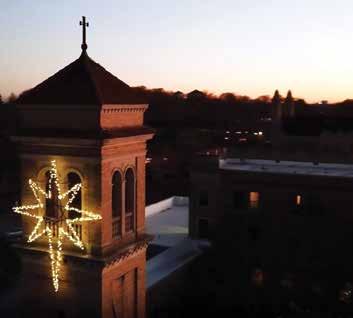



When one has their eyes and heart fixed on Jesus, any occasion can be one of joy—even the Feast of Our Lady of Sorrows. Although the feast focuses on sadness, Legionaries of Christ Father Jesús Salinas said that’s not the end of the story.
“Obviously, Mary was suffering, but she had hope,” Father Salinas said. “She knew there was a bigger plan and that gave her a lot of joy.”
At Royalmont Academy, a private Catholic K-12 school in Mason, instilling the joy of that bigger plan is a priority. This was seen September 15, when the school marked the Feast of Our Lady of Sorrows by installing a new Marian grotto. Father Salinas, school chaplain, blessed the statue and led the service as happy students laid flowers at Mary’s feet.

Father Salinas said the student’s smiles are rooted in Royalmont’s approach. “The most important thing is that our spirituality is Christ-centered,” he said. “Christ is at the center of everything we do. That’s why our chapel is in the center of our school. The first thing we do here when we arrive in the morning is pray and entrust our day to the
Lord. True, authentic joy comes from our interaction with the Lord in the Eucharist.”
Royalmont Academy was founded 27 years ago and formally recognized by the Archdiocese of Cincinnati in 2009. The high school expansion took place beginning with the 2015 school year. There are roughly 170 students enrolled in grades K–12.
“The goal for us is that every single person who comes to Royalmont grows in their personal relationship with Christ,” Father Salinas continued. “If we can establish that, it brings us joy. The rest comes after that. We want to be strong in academics and athletics, too.”
In academics, keeping Christ at the center includes seeing each subject as a gift from God. “Our Christ-centered curriculum permeates everything we teach,” said Anne Polak, Communications and Marketing Director at Royalmont Academy. “Even math and science are the work of God.”
Father Salinas is another source of joy for the students. Each First Friday the school has adoration and benediction, but Father brings extra fun. He rides his electric scooter around the playground, letting students give chase. It’s a small moment that reminds the students that it is a special day.
“Father Jesús just lights up a room,” said Polak. “You can
tell that he cares and loves each student, staff, parent and grandparent. His homilies are always great, and the students are always engaged. Father Jesús brings a lot of love to us all. He knows each student by name and knows each child’s source of joy and some of their struggles, too.”



Ordained in 2019, Father Salinas is in his first assignment as a priest. For him, the joy flows both ways. He enjoys being present for the students and added that he always wanted to work in a school.

“I really enjoy just being around,” Father Salinas said. “Seeing the kids in the classroom or joining them for their lunchtime or seeing them on the playground. That’s where you open the door for conversations and sometimes those can go deeper.”
“I try to be present to the students, to staff, to their parents and families. Sometimes we don’t have to do a lot of things. Just by being you, you are being authentic with them.”
He said the other ingredient for joy is bringing faith alive in every activity of the day.


Father Jones walked the Camino de Santiago, also known as the “Way of St. James,” this past summer.
Rejoicing is one characteristic Father Bob Jones, SM, has embodied throughout his life from school, to priesthood and everywhere in between.
A Fort Wayne, IN, native, Father Jones graduated from the University of Dayton (UD) with degrees in math and education. He later discerned a religious vocation and began formation with the Society of Mary (Marianists).
“I professed first vows in 2007, and worked as a math teacher and campus minister in our schools in Cincinnati and San Antonio,” said Father Jones. “During this time, I also received a master’s degree in Pastoral Ministry from Boston College. Then, I attended the Marianist International Seminary in Rome, living there for three years. After ordination, I spent a year in St. Louis, working as a high school chaplain, associate pastor and hospital chaplain. Then, I came back to Dayton where I was the Chaminade Julienne chaplain for six years,
and am now university chaplain at UD, having started in August.”
Prevalent in the lives of students and others well outside the typical priesthood duties, Father Jones makes himself available to students, faculty and staff when they need spiritual guidance. He also immerses himself in the opportunities God presents to him outside of school hours.
“At the end of July, I was visiting my mom in Fort Wayne,” recalled Father Jones. “We went to Saturday evening Mass at 4:30 p.m. at her parish. At about 4:23 p.m. the cantor (who is also a longtime family friend) came to our pew and said that the piano player didn’t show up. Would I be willing to play? Before I could even think about it, I was walking up to the choir area. When I sat down at the piano, I thought, ‘What am I doing? I don’t even know if I know the hymns we’re doing.’ We couldn’t find music for the ‘Glory to God,’ so I sort of made it up as I went. In the end, I’m glad I was able to help the congregation worship and pray.”
This past summer presented Father Jones with the chance to walk the Camino de Santiago, also known as the “Way of

St. James.” It is a network of trails across Europe that leads to the city of Santiago de Compostela in Galicia, North West of Spain. At a final Mass he and fellow walkers attended, Father Jones was unexpectedly asked to be a celebrant at the Cathedral of Santiago.
“It was a wonderful ending to a wonderful journey, to be able to celebrate the Eucharist in the cathedral,” said Father Jones. “I was invited to pray part of the Eucharistic prayer in English. But the incredible part of the story came at the end. The main celebrant was a bishop from, as another priest told me before Mass, ‘somewhere near Barcelona.’ After Mass, another priest put two and two together. I was a Marianist, and the bishop had three brothers who were Marianists—two whom I knew; one I had lived with in Rome! I was able to meet the bishop, and when he realized I was a Marianist, his face lit up. We talked for a while; luckily we both knew enough Italian to get by. As we were parting, I said something like, ‘This meeting was….’ and I didn’t have the words. The bishop simply said,
‘It was providential.’ He could have also said, ‘Joyful.’”
Father Jones uses his Camino and other life experiences, to spark joy in others, no matter the setting.
“Life can be difficult,” he said. “At times our world seems as if it is in shambles: war, polarization, climate change, racism, divisions, treating others with contempt; the list goes on and on. In the midst of all this, I think it’s good to remember that there are also many things to be joyful about, that God’s goodness can also be seen and felt, and that we can still remain hopeful.”
He continued, “I think the root of joy is to be found in God’s goodness and in hope. I also think that God calls us to joy. This doesn’t mean that we have to have a smile on our face all the time or always have that giddy, playful feeling. But, I think God calls us to a joy that is based on faith and trust in Him, that God is always with us no matter what, that God will never take away His love for us. This can sustain us, especially when life becomes overwhelming.”
Please give to those who have given a lifetime.
Like those pictured, nearly 25,000 senior sisters, brothers, and religious order priests have devoted their lives to prayer and ministry—educating the young, tending the sick, aiding the needy, and more. Yet years of serving for little or no pay have left a profound shortage in retirement savings. Your support of the Retirement Fund for Religious helps furnish care, medicine, and other necessities. Please give generously.

Please donate at your local parish December 10–11 or by mail at: Office for Consecrated Life Attn: Maria Reinagel 100 E. Eighth Street, Cincinnati OH 45202
Make check payable to the Archdiocese of Cincinnati/RFR retiredreligious.org

This can sustain us, especially when life becomes overwhelming .
 BY JILLIAN FOSTER MARYKNOLL LAY MISSIONER
BY JILLIAN FOSTER MARYKNOLL LAY MISSIONER

The Good Samaritan Home in Haiti houses people who are elderly or have disabilities, and it recently welcomed Darcy. He struggles with mental health challenges, but came to the home because a car ran over his legs, breaking both severely. Thankfully, after several infections and a few operations, Darcy is expected to walk again and leave the home.
Darcy had been active and robust, as evidenced by his strong voice and muscled arms. After hearing his story, I expected to find irritation and sadness when we first met at the home—that couldn’t be further from reality. Expressing gratitude to God for the home and for coverage for his medical needs and expenses, Darcy spoke to me with a positive attitude. He even finds energy and spirit to sing his favorite hymns, much to other residents’ chagrin—Darcy often sings loudly when he can’t sleep at night.
He has a great sense of joy, which is not to be mistaken for happiness. I believe joy is a celebration of life, even in suffering. It’s the way we embrace all things with positivity, good humor and a light heart. Joy is a
tremendous gift from God and takes a lot of practice, but once we can fully embrace joy, our burdens become lighter. Two great role models are St. Francis of Assisi and Mother Mary Joseph, the Maryknoll Sisters’ foundress. They inspire me to examine how joyfully (or not) I live my life.
Personally, I could do better at living joyfully. It’s easy to complain after a long day when I just want to go home, but it’s raining really hard so I can’t. It’s easy to feel as if I’m melting in the sun then brush others away to just reach my destination. Since I tend to be an open book, genuine in my actions and words, it’s easy to tell when I’m tired or annoyed. Thus, I avoid social interactions so as to not bring others down. But I could do better. I have to practice breathing and taking in the rain and sun as they are, accepting them not with happiness, but with joy. Feelings are allowed, but it’s important to reorient and let go when the moment calls for it.
Another resident and dear friend, Sauveur, also does a great job at living joyfully. Generally quiet, he welcomes
me warmly with a hug and listens with a smile. He is suffering and still pretty young, yet he always has time to help others. The women in the kitchen and my co-workers at Grepen also share joy, often greeting me with a boisterous “Bonjou!” and asking how I am. There is joy in the way Haitians joke with each other and inject energy into their words, confident and unabashed.
Making efforts toward positivity can create real positivity and lighten the burden. It is sometimes a struggle to practice joy in Haiti because it is hot and many go without. However, that is what makes joy all the more beautiful. It shines through the suffering. Joy is greater than happiness. The feeling of being happy comes and goes, but joy can last. You can be unhappy and still be joyful. With joy, unhappiness might fade into something better, something more beautiful and lasting.
Jillian Foster is a Maryknoll Lay Missioner from Loveland, OH. In 2018, she graduated from the University of Dayton with a BA in Human Rights and minors in Religious Studies, Sustainability and Computer Science. From 2018-2019 Foster served with FrancisCorps in Syracuse, NY, as an assistant in a L’Arche community. She underwent orientation for Maryknoll Lay Missioners at the end of 2019 and entered into mission in Gros Morne, Haiti, in January 2020.


In Haiti, Foster works in several areas, including a tree nursery and mountaintop garden, teaching alternative agricultural techniques to local farmers. She also works at Maison Bon Samaritain (Home of the Good Samaritan).
Outing with the residents and students from the Good Samaritan Home in Haiti.

Whenever I think of joy, I think of Cardinal Timothy Dolan. During the late night show, The Colbert Report , Colbert asked Cardinal Dolan what name he would take if he was elected Pope. After a brief pause and a sly smile, Cardinal Dolan told Colbert—a Catholic himself—“Stephen,” inviting raucous applause from the crowd.

I lived in the Archdiocese of Milwaukee when Cardinal Dolan served as Archbishop of Milwaukee from 2002-09. You couldn’t be around him without feeling joy. But his quick wit, humor and jovial personality are not why I he comes to mind whenever I think of joy. Cardinal Dolan authored a book that forever changed my life.
Called to be Holy, released in 2005, was adapted from his earlier work, Priests for the Third Millennium . While the latter is for priests, Called to be Holy presents many of its themes and ideas for lay people. One chapter includes the four fonts of joy.
FONT 1: THE ASSURANCE THAT GOD LOVES US.
This first font might sound simplistic, but it’s easy to fall into the trap that says God will only love me if I pray more, sin less or give more—that we have to earn God’s love. And some feel they can’t be loved by God because they’ve sinned too much or too seriously. Some struggle to love themselves, so how could they feel assured that God loves them?
Conversion is often built around a radical encounter with God’s love. God’s love is life-changing and joy-giving. Whenever I feel a lack of joy, I remind myself: God loves me.
The chapter’s most intellectually challenging section reminds us that, in God’s radical love for us, He becomes a part of us. Through the Eucharist, God makes each of us His dwelling place. God does not watch from afar, He enters in. He has made our hearts His home and makes His life part of ours.
Whenever I feel a lack of joy, I remind myself: God is part of me.
For me, this is often the most important reminder. When stress, anxiety and worry plague my personal or professional life, it saps the joy from my heart. When things seem to fall apart, it is easy to despair over your life’s direction and what you’re supposed to do next.
The world is chaotic, and it’s easy for that chaos to bleed into our personal lives. National and worldwide concerns, like war and the economy, collide with personal concerns, like finances, health and relationships, to leave us feeling lost. God is in control. He has a plan and makes “all things work for good for those who love Him” (Rom. 8:28).
Whenever I feel a lack of joy, I remind myself: God has a plan for my life.
Prayer is a whole-hearted faith response to God. It is our connection and relationship with God. Some might mistakenly believe prayer is our job, an obligation. But prayer is not our gift to God, it’s God’s gift to us. Through prayer, God gives us instant access to Him. When we pray, the Lord of the Universe hears us.
Whenever I feel a lack of joy, I pray.
These four fonts of joy have become a kind of mantra of my faith. If I feel lost or confused, worried or anxious, I stop, remind myself of three truths and take one action: God loves me. God is a part of me. God has a plan for my life. And I pray.
I hope that, by shining a light on these fonts this month, they fill your life with joy as they have mine.
DOMINICK ALBANO is The Catholic Telegraph’s director of digital engagement, an author and national speaker. He and his wife have been married for 15 years and have four sons. dalbano@catholicaoc.org


The Cathedral Basilica of St. Peter in Chains was built in 1845 as a tribute to the faith of immigrant Catholics. It was rescued from ruin in the 1950’s and today is a shining symbol of that same Catholic faith. But it needs your help if it is to remain that same impressive symbol and home to all Catholic people of the Archdiocese of Cincinnati. Become a “Friend of the Cathedral Basilica” with your contribution to sustain and preserve St. Peter in Chains.
Thank you for your generous donations. Please consider a gift that will be applied to one or more of these important programs:
Please specify how you would like to direct your donation.
Directional & Information Signs to Guide Guests, $27,500
Add to Liturgical Vestments for Concelebrations. Memorial dedications available, $70,000
Installation of St. Joseph Mosaic in the Courtyard, $30,000
New Stone Mensa (top) for the Altar to replace original that is deteriorated, $125,000
Cathedral Basilica Building and Grounds Renovation Rebuild/Repair Bronze Church Entry Doors, $60,000
Repair/Replace Sanctuary Appointments in the Blessed Sacrament Chapel, $35,000
Repair of Damaged Decorative Plaster and Painting, $250,000
Replace Windows and Exterior Doors on Main Floor and Residence to follow the City Historical Guidelines - $150,000
Non-Designated Gift
Mail this form, along with your check to: Cathedral Basilica of St. Peter in Chains 325 W 8th Street, Cincinnati, OH 45202
Your donation is tax deductible. Save a copy of this document for your records!

The Gospel teaches us that those blessed with earthly riches should strive to share their riches with our brothers and sisters who are less fortunate. Sometimes, the riches are an abundance of food and clothing; other times, it is the wisdom and grace to recognize a purpose God placed on our hearts. For three young women from our archdiocese, Katherine Walton, Kirstyn Lee and Ella Kleinhenz, their riches lie in the solid faith foundation that carried them through their lives. They hope to use that foundation to be witnesses of hope for others through NET Ministries.
Founded in 1981 in the Archdiocese of St. Paul and Minneapolis, NET has touched over 2 million youth and young adults through retreats and discipleship. NET missionaries must complete an application and attend a discernment weekend to ensure they are ready to accept the commitment.
“Growing up, I always attended miniretreats and walked away with my faith on fire,” said Lee, “But life always got busy, and slowly, the fire stopped burning so strongly.”
Lee struggled through her freshman year of college. Her mother suggested she take a sabbatical and refocus her energy on the retreats that once fueled her faith and earthly purpose. Lee first rejected the idea, but through prayer and the Holy Spirit’s guidance, she checked out NET’s website.


“I saw the authentic joy that people had. I didn’t know how to get that joy, but I knew I wanted it.”
Ask Katherine Walton about NET Ministries and she confidently says she owes her life to it. “My parents met at NET and served as missionaries 30 years ago. I am honored to follow in their footsteps.”
Initially determined to join NET right after high school, through prayer Walton knew God wanted her to experience college first. “He knew that to go from being homeschooled and with my family 24/7, to leaving my family completely would be hard.”
Once approved to join NET as a missionary, young adults leave for nine months. Their service begins with training to fuel their faith and prepare them for the unconventional lifestyle of traveling in a van and staying with numerous host families along the way.
That nomadic lifestyle is something Ella Kleinhenz never saw for herself. “Growing up, I was always a homebody. So when I told my parents I wanted to travel across the country as a NET missionary, they were definitely shocked.”
She credits her decision to Mary’s intercession, “In college, I was struggling with trying to figure out what to do with the rest of my life. I attended a retreat and met a teen who took a break from college to do

to Mary




it


in their second year of service, the young women reflected on unique moments of grace that have impacted their lives. Walton recalls praying over a group during a youth retreat when she noticed a young girl had distanced herself and was kneeling between pews to write on a paper.

“When I approached her and asked if she had any intentions I could pray over, she handed me a letter about how life experiences had left her struggling to love others. Throughout our time together, it struck me that young teens don’t need to be lectured on how to love Christ, they just need to feel loved. That moment fundamentally changed the way I led small groups.”
Kleinhenz said the most impactful missionary moment for her came when she witnessed a young teen confront a bully.

“We were doing an exercise with a group in which they had to carry around rocks that represented their struggles and burdens. At the end of the day, as they were placing them at the foot of the cross, I noticed one girl crying. She admitted she had been bullied and was struggling to let it go and offer forgiveness.” The young man who hurt her was also at the retreat in another group, and she decided to finally approach him. The exchange was grace-filled and ended with a hug. “There have been times where I wondered if all of my efforts were making a difference. God showed that day that they truly were.”
For Lee, her pivotal moment came when the Holy Spirit helped her guide a teen struggling with prayer. “She told me she had all of these things that were holding her back from praying with her whole heart. I asked for the Holy Spirit to intercede because I, too, had been struggling with deep, meaningful prayer.” Lee asked the teen to imagine she was holding a rope. Tied to the end of that rope is a cinder block, and her hands are calloused and bleeding from pulling that heavy rope every day. “Then I said to her ‘All you have to do is let go. All those wounds will heal. All that weight will be released if you just let go,’ and I was in awe. Those weren’t my words but they have forever impacted my life.”
Through NET, these three young women are sharing their joy and riches with others by the power of evangelism. Please pray for them as they continue opening young hearts and minds to Christ’s love and to the community of the Church. For more information on NET Ministries, visit netusa.org.
What brings us joy varies from person to person. Father George Jacquemin finds joy in a hobby that connects him to his roots and God’s creation: beekeeping.



Raised on the family farm in Fairfield, Father Jacquemin often played with beekeeping equipment stored for his father’s agricultural studies at Ohio State University. “It was something fun to do on rainy days,” he said.

It wasn’t until many years later, when Father Jacquemin became pastor at St. Bernard Parish in Winton Place (now Spring Grove Village), that his interest in beekeeping really took hold. Deacon intern Tom Stricker was involved in beekeeping, which intrigued Father Jacquemin.
“I told him, ‘I’d like to try that,’” the priest recalled. “The next spring, he had a swarm of bees and said, ‘Here you are.’

Then, I caught a swarm of my own on the farm.”
From those two hives, Father Jacquemin’s
collection has grown to between 15 and 20 hives at any given time. Unable to keep that many colonies at the parish, he tends to them at Centennial Farm, aptly named for the 100 years it’s been in his family.





“Beekeeping has been a great hobby for me,” he said. “When you’re working with bees, you can’t be distracted by anything else that’s going on in the world or at the parish. You can just leave everything behind. If you make a mistake, you’re going to pay for it by getting stung.”
“It keeps me in tune with nature and very aware of the seasons,” Father Jacquemin added. “I’m very much aware of what is blooming and when, what the bees can get pollen from, then making sure they’re prepared for winter.”
Much of the joy he experiences is “being drawn back to the family farm and staying in touch with my roots,” especially since one of his brothers still works the farm, and another is a fellow beekeeper.
Father Jacquemin finds great joy in the lessons to be learned from bees, both personally and spiritually. “The bees themselves are a joy to observe and care for,” he said. “They have a very complex society, a matriarchal society, with the queen bee as the ruler. They all work together collaboratively, using their gifts—gathering the nectar for honey,
on page 24

Fr. George Jacquemin
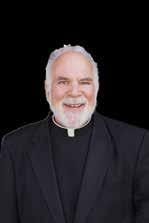
for his 50 years of service as a priest and his decades of dedicated beekeeping.
Fr. George, you (and your bees) are a gift to us! Ad multos annos!
continued from page 23
guarding the hive, clean up duty—for the good of the whole. Scripture even refers to that. We can learn from the gifts of one another, and the Church and society today can learn that from the bees.”
There’s also the joy that comes from drawing closer to God through prayer and connecting with His creation.
“There are many ways to pray, many ways to deepen your relationship with God,” Father Jacquemin said. “Sometimes I feel closest to God when I’m in the midst of nature, whether it’s a snow storm, the sunrise or sunset, a mountain or the bees. They help me stay in tune with God’s presence around me and that’s a deep part of my spirituality.”
Ordained in 1972, Father Jacquemin has served at St. Clare Parish in College Hill since 1998, most of that time as pastor and now as parochial vicar. The fruits of the bees’ (and Father Jacquemin’s ) labors also bring joy to others through the sale of honey and beeswax gift items, including Christmas ornaments, Nativity sets and candles. He typically makes his wares available one weekend in the fall at St. Clare.
Father Jacquemin also established a relationship with Brink Brewing in College Hill, which purchased 120 pounds of honey in 2017 for what was named “Father G’s Bees Honey Brown Ale.” This hometown brew won a gold medal at the Great American Beer Festival in Denver last year.
“It’s been a real blessing for me to be at St. Clare. People enjoy the honey, and it gives me joy to be able to share it and draw closer to the community. [They] seem to enjoy hearing about the bees and receiving my farm reports.”

in

What do you want out of life? That’s a big question, right? I think we all, on some level, want our lives to be full and joyful.

What does it mean to be joyful? You could say a lot of things in response to this question. Perhaps that joy is “being happy” or “finding the good in every situation.” There are plenty of saccharine niceties, but true joy comes from a life lived in the freedom of belonging to God.
When we know who we are as beloved sons or daughters of the Father, and we know we are made for intimacy of communion with Jesus Christ and His people, then we can truly see all as gift.
This is what it is to live in the freedom and the fullness of the Spirit! I think if we are honest with ourselves, we don’t really know the Holy Spirit. Sure, we know the Holy Spirit as the third person of the Trinity; but do we personally know the Spirit in a way that gives our life peace, joy and love? A relationship with God in the Spirit changes us and fills us with an abundance of supernatural life, with grace, and this can’t help but be noticed by others.
A person living in this way has something about them that resonates with all of us on a deep and yet very basic human level. Think about someone you know who is joyful. They bring this gift with them into their conversations, their perspectives, their way of being. And we who see it can’t help but appreciate them for who they are. When we are with them, we can’t help but smile or be lightened by their presence, even if it is in the smallest way.
Therefore to be joyful is to radiate Christ in a way that makes life more abundant.
When we are living for Jesus, we are positioned to be present to what is before us. In doing so, we are able to live each moment with the joy of Christ, who is the source of a full life.
“I came that they may have life and have it to the full.” (Jn. 10:10)
FATHER ETHAN MOORE was ordained a priest for the Archdiocese of Cincinnati in May 2015. He is the head chaplain for the University of Cincinnati campus ministry and pastor of the Uptown Catholic Region which includes the parishes of St. Monica-St. George, Holy Name and Annunciation. Father is a big fan of Chic-Fil-A sauce, motorcycles and karaoke–but mostly living in the Spirit for Jesus!










 BY KARY ELLEN BERGER
BY KARY ELLEN BERGER
cheerful giver doesn’t have to be someone with immense finances. It’s someone who understands that their financial worth on Earth does not equate to their treasures in heaven. This is true for multiple donors who pledged to share their wealth with the Catholic Ministries Appeal (CMA), a mission connected to the archdiocese that focuses on six ministries that help heal, teach and feed those in our area.
“Every year the support of so many generous donors across the archdiocese is truly humbling,” said Matt Reinkemeyer, the Director of Development Operations in the Stewardship Department. “That has been all the truer this year with the CMA receiving more than $6.1 million in pledges to date, making this the best CMA year ever and the first-time to ever exceed $6 million in support.”
“For donors to support us with that level of generosity— especially in a year where inflation and rising costs have dominated much of the financial news—is truly a humbling gift,” continued Reinkemeyer. “It’s also all the more needed since inflation and rising costs are taking their toll on the ministries supported by the CMA, as well.”
“Giving is a joy-filled experience once you make the mental and spiritual transformation from ‘owner’ to steward,” said one anonymous donor. “When I thought and operated as if I were the owner of myself, my things and my wealth, then giving money was a loss to me. It was hard to do. When I became a steward of God’s gifts to me, then charitable giving became a transfer of God’s wealth, not mine, and thus it became, not a loss, but a source of joy.”

“There is no better way to let your light shine than to financially support the Church,” said Mark and Elizabeth Tebbe. “Since we are the Church and we want Her to grow and be extremely vital in the community, we must provide financial support. Instead of purchasing a specialty coffee, put that money into the collection at Church. Jesus sacrificed so much for us. The least we can do is see that His Church continues to stand up for what is right, provide for the needy, protect the young and the vulnerable and especially support those who are called to vocations of the religious or priesthood. It is truly in giving that we receive.”
Another pair of donors added, “Accumulating wealth does not give one the freedom to hoard all of their income for themselves or simply save it to pass on to their children. We are entrusted to be wise stewards of these gifts. Because we are so blessed, I believe God will hold us even more responsible to share with others what he has given to us. There are many ways to give and many worthy organizations to support. We have found joy and trust in our choice to support the CMA.”
Those wishing to give to CMA, but who currently lack sufficient financial resources, can support it through actions like prayer, being an ambassador and volunteering.
“Generosity, financial or otherwise, offers us the opportunity to exercise faith, hope and charity if we truly allow these virtues to motivate our actions,” noted Reinkemeyer. “This in turn brings us joy, which is a much deeper sense of fulfillment and peace than the emotion of happiness. Generosity becomes a source of grace when we can give from a place of joy and receive God’s joy in the process.”

At Christian Family Credit Union we believe it really does matter where you do your banking!
When you bank with us, your money is put to work building the Kingdom of God. While we offer all the banking options you need, the mission and values we embrace matter most.
Our Mission is to glorify God by caring for His people in a way that helps them become better financial stewards. Align your finances with your faith when you and your family bank with Christian Family Credit Union.
LEARN

Kevin Schmiesing’s new book, A Catholic Pilgrimage Through American History, demonstrates that you cannot go far along the highways and byways of the U.S. without stumbling upon a site important to both the Catholic faith and our nation’s history. Dr. Schmiesing, who hails from Sidney, OH, explores the Catholic dimension of our national story through 27 short chapters, each detailing a place, person or event. The short chapters are perfect for leisurely reading; the reader will never have to leave a chapter unfinished.
In choosing his topics, the author is not entirely impartial: numerous vignettes convey Catholicism’s story in the Midwest, including two in the Archdiocese of Cincinnati. Of particular interest are a chapter on the anti-Catholic riot that broke out at the Cathedral of St. Peter in Chains in 1853, and one on how Maria Stein became home to one of the nation’s largest collections of saints’ relics. Another tells of Cincinnati Sister of Charity Blandina Segale, who ministered in the Wild West.
A great historian must be a good storyteller. Dr. Schmiesing is both. The chapters are well-written and fast-moving, consisting of intriguing and entertaining vignettes that provide essential context without getting bogged down in details. The stories successfully connect with broader themes in U.S. Catholic history—immigration, the role of race, geographic expansion, political influence, foreign affairs and responses to prejudice—which provide a lesson in the contours of national history. A refreshing aspect of this book is the sheer diversity of personalities: priests, religious and laity, “good” Catholics and not-so-good ones, cradle Catholics and converts, Catholics and non-Catholics.
For those readers versed in U.S. Catholic history, the book
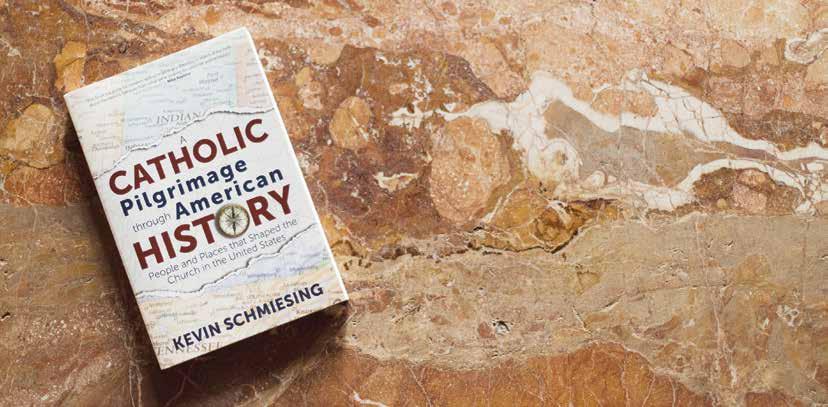
covers familiar territory, including the Spanish Missions, Catholicism on the frontier and the English Catholic founders of Maryland. But there are plenty of lesser-known stories, such as the 1813 court case that enshrined the confessional seal in law, the 1886 murder of a bishop in Alaska, and the role of Catholics in President Lincoln’s assassination (with the reader left to judge their involvement).
For the beginner, the book offers sufficient explanation of persons and events so that no reader is left behind. Dr. Schmiesing introduces each chapter by honing in on a specific person, place or event before widening his discussion to pertinent context, often explaining what predated the chapter’s focus. He then proceeds with the story, before ending with a discussion of the chosen vignette’s legacy or significance.
Among my favorite chapters is the story of the Pope’s Stone— the stone gifted by Pope Pius IX for use in the Washington Monument’s construction. Anti-Catholics stole the stone in 1854, worried that its inclusion in the Monument would symbolize the victory of a tyrannical papacy. The stone was smashed to pieces and thrown into the Potomac River—none of the thieves were ever apprehended.
The stories within A Catholic Pilgrimage Through American History reinforce the prominence of Catholicism in our nation’s history. This well-crafted itinerary assists readers in exploring historically-rich places, reminding us that whether we seek them out in person or vicariously, the sites important to U.S. Catholic history are within our reach.
A






God’s beauty surrounds us everywhere. Let your eyes see His beauty on His 160 acres of the Archdiocese of Cincinnati, Gate of Heaven Cemetery.

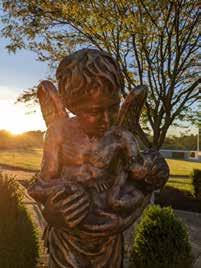


Every year we reach out to the community to capture the beauty, spirit, and art in Gate of Heaven landscaping, not just through their eyes, but through the lens of their camera or phone. Engage in this wonderful experience now, and through the seasons, as we prepare for the annual 2024 calendar to share the magni cent beauty of this sacred ground with the community.
“God is such an artist in nature. His "box of crayons" has so many more colors than man could ever imagine or create. I love to capture His masterpieces at Gate of Heaven Cemetery with my cell phone camera and share the pictures with others. I try to post a picture of something from God's creation every day with a corresponding scripture from the Bible. My goal is to cancel out the negativity on social media and replace it with God's love and message of hope. These symbolic pictures catch people's attention, taking in a little of God's message.” - Shannon Ritter, Photographer Gate of Heaven Photo Competition 2022
What is hospitality? You might say hospitality means welcoming people and making them feel at home. It means being friendly and generous, especially toward strangers. This is true—but when we turn to the Bible, several themes indicate there is much more at stake.
The Modern Catholic Dictionary has a shocking definition of hospitality: The virtue of kindness and generosity toward guests. It is characterized by the spirit of welcome to visitors and strangers, and is one of the conditions for salvation, foretold by Christ: “I was a stranger and you made me welcome” (Mt. 25:35).
“One of the conditions for salvation!” That seems harsh, but since it comes from Jesus, we can’t dismiss it. In Matthew 25, Jesus tells us that, at the end of time, we will be judged by how we served strangers and the needy. Specifically, we must serve them as if they were Jesus! If we don’t, we will “go away into eternal punishment” (Mt. 25:46).
Hospitality is not optional to the Christian life. Our souls are measured by, among other things, how faithfully we provide hospitality.
Hebrews says, “Do not neglect to show hospitality to strangers, for thereby some have entertained angels unawares” (Heb. 13:2). The part about entertaining angels is a reference to a couple you might know: Abram and Sarah.
In Genesis 18, Abram (later Abraham) is sitting at the door of his tent when three visitors suddenly arrive. Eager to serve, he promises water to wash their feet, a place to rest under his tree, and bread (Gen. 18:3-5). Interestingly, what he ultimately delivers is much more: cakes, curds, milk and even a calf to eat!
This isn’t bare-minimum hospitality; this is hospitality that defies expectations. This is radical hospitality, and since Abraham is our father in faith, this should be the hospitality we strive to offer.
We tend to think of hospitality as our way of blessing others, but in hospitality, the stranger also blesses us. If Abram rejected his visitors, he would never have received the good news that Sarah would finally conceive a son. Like Mary and her “Yes,” all of salvation history hinged on his hospitality.
When we say “Yes,” we are blessed, too. After all, every person we meet brings his or her own gifts, talents, charisms, knowledge and experience with them. We have no idea how the next visitor could enrich our lives and parishes, which is all the more reason to warmly welcome everyone.

The final theme comes from St. Peter: “Practice hospitality ungrudgingly to one another. As each has received a gift, employ it for one another, as good stewards of God’s varied grace” (1 Pet. 4:9-10).
A gift employed for another—that is a charism. Hospitality is one of the “varied graces” God dispenses for the benefit of others and the Church. Charisms bring great joy and fruitfulness. But, just because some people have the charism of hospitality, the rest of us are not exempt.
We might tend to think of hospitality as the sole realm of the usher and secretary. But the warmest greeting by an usher can be immediately undone by a parishioner’s harsh word or dirty look. The only way parishes become beacons of hospitality is for all of us to make hospitality our responsibility. When everyone in a parish is welcoming, serving, blessing and being blessed, then we can be sure that when we meet Jesus, He will show us the greatest hospitality by saying, “Come, O blessed of my Father, inherit the kingdom prepared for you from the foundation of the world” (Mt. 25:34).
NICHOLAS HARDESTY is the associate director of Adult Evangelization and RCIA for the Center for the New Evangelization. | nhardesty@catholicaoc.org


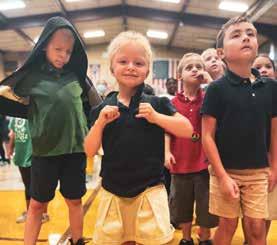





I’m a big fan of Garth Brooks, and have been since the tiny age of three when “Friends in Low Places” thrilled country radio stations. His music is etched in my heart. My parents saw him live when I was seven and brought home his autographed photo—complete with my name scribbled by the man himself. I’ve seen him myself in concert three times and belted every lyric from the depths of my heart.
I’m a huge fan of Dave Ramsey. His financial principles make cents (see what I did there?) and implementing them keeps Andrew and me on a road of certainty with our cash flow. Years ago we facilitated his course, Financial Peace University, and attended his Smart Conference twice. When my best friend told me to go work for him, I joked that he can’t afford my enthusiasm.
But I don’t know either of these guys. Despite all the lyrical and lucrative knowledge, I have no relationship with Garth or Dave. We’re not friends and never will be. I’m a fan—and the nature of fan-ship is admiration from a distance.
While in college, I found wide-eyed wonder and respect for St. Elizabeth of Hungary. Most know her love of the poor, but what drew me to her was her devotion to her husband, Louis, and her deep friendship with him. Her love for Louis was so overwhelming that she prayed for the grace to withstand it. Freshly engaged, I tried to emulate her prayer and dedication in my relationship with Andrew, and I currently include her example in every keynote I give. I realized recently that I haven’t invoked her aid in years. She’s at the top of my “Saints Who Inspire” list, and I happily sing her praises, but I haven’t connected with her for a while. Admiration from a distance.
This distance, however, can be breached. Thanks to the grace of God and nature of heaven, the saints who behold His Face are accessible regardless of time or tongue. When we’re drawn to people on earth, they become friends. Consider the behaviors and insights you’ve learned from your closest friends and how
they affected your life; consider how a similar bond with a saint would be more fruitful because they experienced the same earthly struggles then went on to win the imperishable crown. The saints are not resources or stories to enjoy but friends to pray with and for us. They offer hope and strength through their written words, prayerful intercession and presence by our sides while we fight the good fight. For my whole life I’ve had favorite saints whose stories fascinate me or virtues I want to mimic. Isn’t that admiration a nudge from God? Go on, He says, you guys will get along great.
Incredible and fruitful friendships with the Church Triumphant are available to us now, and all we need to do is speak up. So, I’ll talk to my friend St. Elizabeth when I need to recommit to sacrificial love in my marriage. I’ll talk to St. Monica when asking help for fallen away Catholics in my life. I’ll ask St. Therese for her humility because it’s the virtue I want most, and I’ll ask Mary Star of the Sea to guide me to Christ daily.
And you know what? They’ll respond. A person who’s achieved perfect holiness isn’t going to snub someone who asks for help or company on the journey. Whether we perceive a response from our brothers and sisters in heaven, we are assured of their support. The saints are happy to be in heaven and happy to help others get there, too.

My life has crosses. Along with Christ, who better to help me carry my part than those I admire who are capable of both loving God perfectly AND conveying his love to me? Don’t waste time being a saint’s fan when a connection deeper and more profound is yours to enjoy. For the feast of All Saints, answer the nudge to connect with the saints you admire, and change your fan-ship to friendship.
KATIE SCIBA is a national speaker and Catholic Press Awardwinning columnist. Katie has been married for 14 years and is blessed with six children.

1953
Parish established in June by Archbishop Karl J. Alter. Father James Lunn was the pastor. It was named for St. Ann Church in the West End. First Masses held at Groesbeck Community Hall.
1954
St. Ann School opened and run by the Sisters of St. Francis (Sylvania, OH).
1955, 1956
Convent and rectory built.
1959
Church dedicated. It was built of brick and concrete in a spare, modern style.
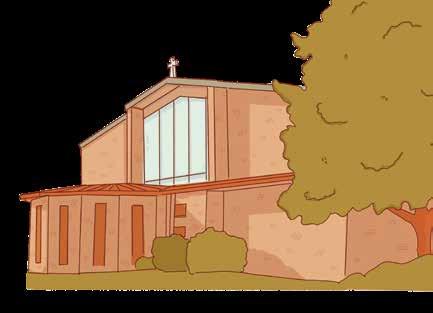
1961
Ten-room school addition opened.
1980


Church renovated and new Monsignor Lunn Parish Center dedicated.
2004 Church renovated.
2008

Several parish schools consolidated. St. Ann School reopened as Our Lady of Grace. As of 2022, the school serves children from nine school districts.


2010
Dedicated grotto and Prayer Walk, featuring Stations of the Cross and benches.
2013
Convent/Friary converted to offices and meeting rooms and renamed the St. Francis Center.
2015
Began Church enhancements, including a renovated sanctuary with painted barrel vault and sanctuary windows. Chapel converted to baptistery; it has stained glass windows representing the seven sacraments.
Written by Gai Illustrated by Emma CassaniSt. Ann Church in Groesbeck built its school first, where it celebrated Masses for six years until the church was built.
Ann (also spelled Anne) is the name multiple non-Biblical sources give to the Blessed Virgin’s mother. She is often pictured embracing her husband, Joachim, at Jerusalem’s Golden Gate after angels told the elderly spouses, separately, that they would conceive a daughter preserved from original sin. St. Ann is also frequently shown teaching the child Mary. Early theologians taught that while God gave Mary supernatural knowledge and the full use of her reason, St. Ann instructed her in all earthly things. She’s the patron saint of unmarried women, married women and childless couples.

9 Days of the annual St. Ann Novena, celebrated with daily Masses leading up to the Feast of St. Ann on July 26.
2 Major stained glass windows featuring Melchizedek and Christ.
“God is good all the time. All the time God is good.” Motto flanking the sanctuary in gilded letters.
St. Ann, West End Organized in 1866, St. Ann was an African-American parish originally located on Longworth Street between Race and Elm streets. It moved locations several times before merging with St. Edward in 1938, and closed in 1965.
“The enhancements were done in stages, starting with putting the tabernacle back in the center, and focusing on what God does for us in the sacraments. The main windows depict Melchizedek, the ‘Priest of Righteousness,’ and Christ, the true Priest of Righteousness, who offers sacrifice for the world. Our bodies and souls are both eternal, and a church should have a beautiful ‘body’ that leads our souls to contemplate eternity.”
- Father Tom McCarthy, pastor during renovations
“The starry ceiling represents the dome of the sky and God’s promise to Abraham. They’re shown during daytime because the Lord asked [Abraham] to count the stars during the day. It takes faith to believe the stars are out there even when you can’t see them.”
- Father Tom McCarthy, pastor during renovations
St. Stanislaus was born in Rostkovo, Poland, in 1550. Although he grew up in a wealthy family, his older brother often bullied him. A serious sickness overtook him at age 15 while he attended a Jesuit college. During that time, no one helped him receive the Blessed Sacrament.
He prayed to St. Barbara and she interceded for him. One account states that two angels brought him the Blessed Sacrament, and another says Mary placed the child Jesus in Stanislaus’ arms. His health soon returned, and with it he received a desire to enter the Society of Jesus.
Despite family pressure to avoid his religious calling, Stanislaus walked 425 miles to join St. Peter Canisius’ Jesuit community. Once St. Canisius understood Stanislaus’ character and

virtue, St. Canisius sent him to study in Rome.


After walking another 345 miles to Rome, Stanislaus studied for only nine months. While it was common for him to be in poor health, he eventually became deathly ill. On the morning of his death, Stanislaus said he saw Mother Mary and the angels, who were soon coming to receive his soul into heaven. He died at age 17 on the Feast of the Assumption in 1568.
He prayed often and displayed a readiness to suffer well. Throughout his life Stanislaus was known for his patience, constant joy, purity of heart, and love for heavenly things.
St. Stanislaus is the co-patron saint of Poland and the patron of youth and Jesuit novices. St. Stanislaus, Pray for Us.


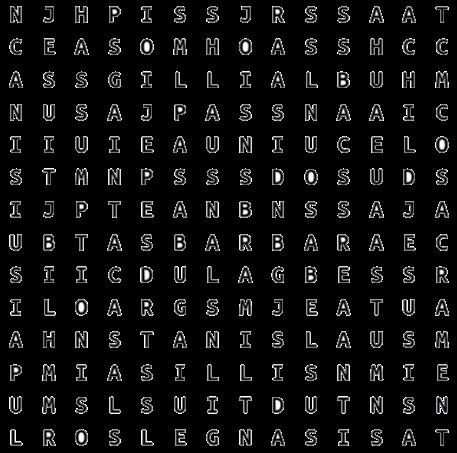









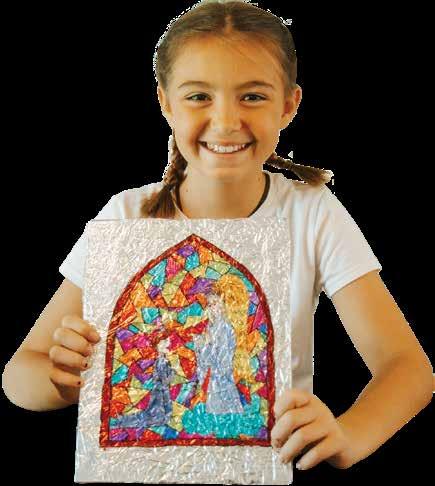


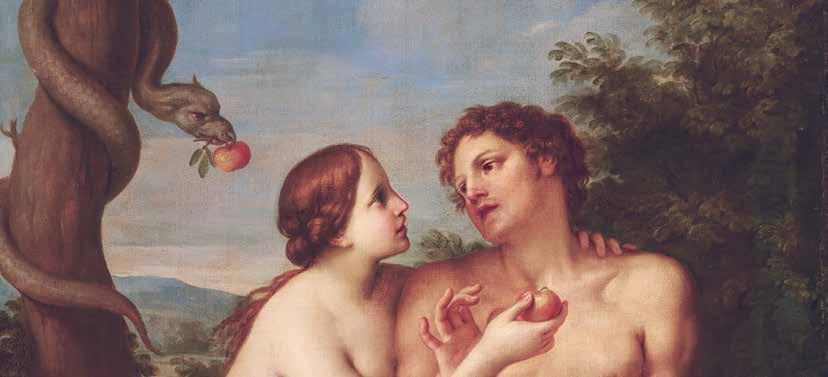
This article is part of an ongoing series on Pope St. John Paul II’s Theology of the Body (TOB).
In last month’s reflection, we explored the state of our first parents at the beginning of time, which was marked by the Four Harmonies—between man and God; within man himself; between one another; and with the rest of creation.
When we reflect on our own experiences, we quickly discover that, for each of us, these relationships are not marked by persistent harmony, but significant disharmony. This difference is the clearest indication that we exist in a different state than our first parents. The primordial event that separates them from us and radically changed the state of our humanity is what we refer to as original sin.
We are all familiar with the story in Genesis 3 in which the serpent tempted the woman to eat of the tree of the knowledge of good and evil, how she succumbed and induced the man to do likewise, and how their situation before God and before each other was altered for the worst. We know that prior to this tragedy the man and woman did not experience the inclination to sin that we now experience. They experienced the Four Harmonies and were filled with God’s grace. How is it that they could fall into sin? What was the nature of their sin?
In our experience, temptations to sin come from a variety of sources, which Scripture and Tradition have summarized as the flesh, the world and the devil. That is, temptations to sin come to us from within our fallen human nature, from the negative influence of others and from demonic influences. However, our first parents, being filled with grace and possessing a fully integrated human nature, could only experience temptations from external sources. Scripture identifies the source of their temptation as the “serpent” (Gen. 3:1) who is later revealed to be “the great dragon … that ancient serpent, who is called the Devil and Satan, the deceiver of the whole world” (Rev. 12:9) and whom Jesus refers to as “the father of lies” (Jn. 8:44). Satan and his demons, who were created good and “endowed with knowledge and freedom had been ‘put to the test’ so they could make their choice commensurate with their purely spiritual nature” (Sept. 10, 1986). At the outset of creation, Satan and his demons “radically and irrevocably rejected God and his reign” (CCC 392), preferring themselves to God out of pride. In their consequent exile from heaven, they seek to subvert God’s reign wherever they can, and so tempted our first parents into sin.
The tempter succeeded in his effort to provoke humanity’s fall from grace by inducing doubt of God’s goodness. In Genesis 3:4-5, Satan distorts the words of the Creator and
In our experience, temptations to sin come from a variety of sources, which Scripture and Tradition have summarized as the flesh, the world and the devil.
sows seeds of suspicion and rebellion in our first parents. Specifically, he plants the idea that God’s law, rather than being an expression of His wisdom and love, is merely an arbitrary imposition to ensure our subordination. If we rebel, as the lie goes, we can become “like God,” no longer dependent on our Creator. Rather, we can become gods ourselves. It is as if Satan is saying to our first parents— and to all of us—that God is holding you back and you will never be fulfilled unless you take what you want and ignore His presumptively false warnings and apparently arbitrary rules. Under Satan’s influence, God no longer looks like a loving Father and the bestower of gifts more numerous and immense than we could ever deserve. Rather, He looks—in this demonic distortion—as an evil tyrant who is uninterested in our fulfillment, seeking only to control us while keeping His greatest blessings for Himself.
The tempter succeeded in undermining our first parents’ trust in their loving Father. Through their disobedience, they rejected God’s love as well as their status as creatures, seeking rather to supplant the Creator. As Pope St. John Paul II said, they gave in to “love of self to the point of contempt of God” and in so doing, “became the slave and accomplice of the rebellious spirits” (Sept. 10, 1986).
In subsequent reflections, we will continue to explore the tragedy of sin, especially its impact on the relationship between the sexes, as well as God’s unrelenting pursuit of our redemption.
 DR. ANDREW SODERGREN, MTS, PSY.D.
DR. ANDREW SODERGREN, MTS, PSY.D.

is a Catholic psychologist and director of psychological services for Ruah Woods. He speaks on the integration of psychology and the Catholic faith. He and his wife, Ellie, have five children.








Mia Napier and Belle Grubert formed the Purple Ribbon Project at St. Ursula Academy for the 2022-23 school year. During the school’s recent Club Fair, they showcased the new club, recruited members and spoke about their mission to spread awareness and fundraising efforts for various types of cancers.

Sister of Charity Barbara Davis was honored by DePaul Cristo Rey High School’s Founders Leadership Award at the school’s annual Founders Day Mass on Sept. 19. This award honors those who demonstrate the inspiring qualities of St. Vincent de Paul and the school’s founders, the Sisters of Charity of Cincinnati.
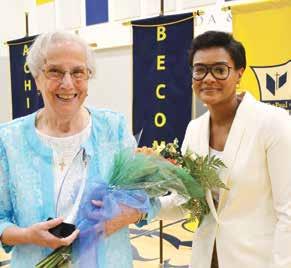
Following Mass at Holy Name Church in Mt. Auburn, parishioners processed with the Blessed Sacrament from Holy Name to Planned Parenthood, where they prayed the Holy Rosary for recognition of the sanctity of life and to speak for the innocent unborn who have no voice.
The Eucharistic Procession then returned to Holy Name Church for the repose of the Blessed Sacrament.
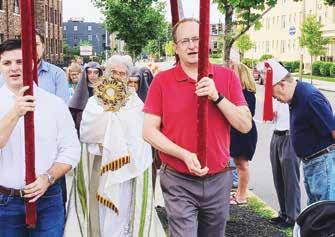
The Summit Country Day School welcomed the school’s state championship relay team back to campus with a celebratory assembly. Braeden Austin, Oren Jenkins, Oscar Loehrer and Matthew Shuler, as well as alternates Grant Desch and Luke Bulla, became the first athletes at The Summit to win gold for a relay.

Home
Beechmont Ave
Steve Rohde,
513-263-6635.
513 231 7150
2050 Beechmont Ave. | 513.231.7150
Washington/Anderson
owned
& operated since 1870
operated since 1870
NAEGELE KLEB & IHLENDORF
Montgomery Rd.
Norwood, St.
513.631.2240
Catholic familyowned funeral home since 1877 513.891.8373

A Catholic Family Owned Funeral Home –Since 1877 513-891-8373

 FRITSCH
FRITSCH



The Tribunal Office is trying to find Branden Marc Chwalek.
know
whereabouts, please call the Tribunal at 513-263-3393 or email cengelke@catholicaoc.org
When I was a little girl, my sister and I sang the children’s Bible school song lyrics: “I’ve got the joy, joy, joy, joy down in my heart.” We sang it with complete abandon, at full volume, with our heads thrown back. We meant it and felt it. As the verses progress, the words get faster and faster.
We’d sing as fast as we possibly could: “I’ve got the wonderful love of my blessed Redeemer / Way down in the depths of my heart …”
And we would laugh with clear, simple joy. Laughter was the childish response we had to that extreme goodness of the Truth in the song, the closeness of each other, the delight of the day. That experience of joy, as irreverent as it was, was a real introduction to a deeper sort of joy— one linked to our relationship with God.
Joy is one of those invisible realities we understand from our experience with it. It is impossible to describe with mere words or images or sounds. Joy is experienced in the wide incarnational world: in color, scents of paint and sun-warmed bronze, in reclaimed clay and in new ideas.
Pope Emeritus Benedict XVI teaches that Christian joy is something we receive “from the encounter with the living Person of Jesus.” An encounter with Jesus is an encounter with beauty. And the Catholic artist’s challenge is to address that beauty in sculpture’s permanence or poetry and music’s ephemeral sounds. Joy, hope, love: these unseen realities are the seed and fruit of the artist’s work.
I am keenly aware of my small little prayer, amid the river
of saints and encircled by the whole music of words, bells and light that are amplified into something beautiful at Mass. That is joy.
There is joy in knowing we are made in the image of God, imago Dei. We are made from the same dust that God used to make the stars.
When some years ago, I told my dear friend, Joan, that I was again facing chemo, she warmly responded she was there for me “with tea and sympathy or wine and gladness.” Wine and gladness! My daughter painted the phrase on our kitchen wall in gold with flourishes, to remind us that joy in friendship and deeper joy in the presence of God are ours to claim. Joy is created in love.
We can cultivate joy as virtue, and develop our capacity for joy with reminders, prompts and practice. Especially as artists, we can be receptive to the little gifts of joy. We can take joy in the quiet of a sunrise and in a little child skipping in her cowgirl boots.
But, most importantly, we can take joy in the knowledge that God the Creator of the Universe loves us with a joy that inevitably spills into our lives and our work.
is a sculptor, art teacher, co-founder of The Angelico Project and Director of the Angelico Catholic Arts Guild, a lay Catholic initiative whose mission is to nurture artists’ faith and work. A Third Order Franciscan, she loves her Dominican parish, St. Gertrude. She and her husband, Jack, have four children and twelve sparkling grandchildren.




Amen is the Catholic audio app that brings you beautiful prayers, faithful meditations and nourishing Scripture to draw your mind, body and soul to rest in God . . . and it’s completely free.



